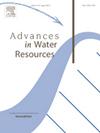Reactive precipitation during overlaying CO2 dissolution into brine: The role of porous structure
IF 4
2区 环境科学与生态学
Q1 WATER RESOURCES
引用次数: 0
Abstract
After sequestration of CO2 into subsurface saline aquifer, CO2 cap forms at the top of a stratum. As overlaying CO2 dissolves into brine, precipitation reactions between CO2 and in-situ ions emerge. The role of reactive precipitation during this process has long been under debate due to the lack of direct observation. Here we conduct visualized experiments on high-pressure CO2 convective dissolution into Ca(OH)2 solution, where CaCO3 precipitation forms. We show that the presence of a porous structure largely shapes the dissolution pattern. In absence of porous structure, sharp and flat reactive front is observed, with cloudy particle suspension chaotically flowing; however, in presence of a porous structure, symmetric fingers are observed above the reactive front, and precipitates locally deposit at the pore-scale without participating in convection. We theoretically rationalize these observations and discuss their impacts on CO2 dissolution kinetics. Inspired by these experimental observations, we propose several major simplifications for numerical modeling. This work also provides a benchmark for future experimental and numerical studies of CO2 convective dissolution with reactive precipitation during CO2 sequestration.
求助全文
约1分钟内获得全文
求助全文
来源期刊

Advances in Water Resources
环境科学-水资源
CiteScore
9.40
自引率
6.40%
发文量
171
审稿时长
36 days
期刊介绍:
Advances in Water Resources provides a forum for the presentation of fundamental scientific advances in the understanding of water resources systems. The scope of Advances in Water Resources includes any combination of theoretical, computational, and experimental approaches used to advance fundamental understanding of surface or subsurface water resources systems or the interaction of these systems with the atmosphere, geosphere, biosphere, and human societies. Manuscripts involving case studies that do not attempt to reach broader conclusions, research on engineering design, applied hydraulics, or water quality and treatment, as well as applications of existing knowledge that do not advance fundamental understanding of hydrological processes, are not appropriate for Advances in Water Resources.
Examples of appropriate topical areas that will be considered include the following:
• Surface and subsurface hydrology
• Hydrometeorology
• Environmental fluid dynamics
• Ecohydrology and ecohydrodynamics
• Multiphase transport phenomena in porous media
• Fluid flow and species transport and reaction processes
 求助内容:
求助内容: 应助结果提醒方式:
应助结果提醒方式:


